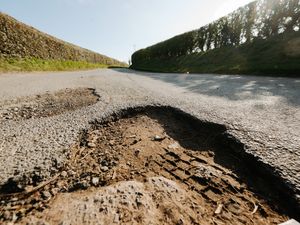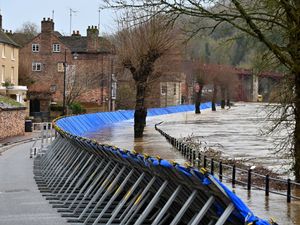Watch: Crack team tackling Shropshire's pothole menace
Pothole doesn't really cover it, it's more of a crater - about 2ft long and four inches deep, and filled with cloudy rainwater seeping into the surface below.
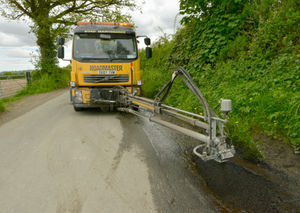
This eyesore at the edge of a country lane just outside Shrewsbury must have been the scourge of motorists for days
Carefully manipulating his joystick with the delicate precision of a keyhole surgeon, Gavin Andrew is the man tasked with repairing this ravaged road.
A touch to the left, a little to the right, Gavin's deft strokes control a large arm to the front of his truck, which begins the process by blasting the water out of the hole until it is dry enough to refill.
A quick spray of hot tar, followed by a mixture of bitumen and aggregate, are poured in by remote control while Gavin drives his vehicle back and forth, to ensure an equal spread.
Finally, he smooths the surface using his truck's built-in roller, and sprays some dry chippings on top to act as surface dressing. After about 10 minutes it's job done, and Gavin, who lives in Shropshire, is off to his next job.
"I probably fill about 100 to 150 potholes a day," says Gavin, who lives in Shrewsbury, during his fleeting visit. "I will use about 10 tons of material every day."
Gavin's Roadmaster truck is Shropshire highways team's weapon of choice when it comes to repairing the countless potholes which mar the county's rural roads.
The authority is about to take delivery of two new Roadmasters, which cost about £220,000 apiece.
The Roadmaster is an impressive piece of kit which enables skilled operatives like Gavin to repair the roads in minutes without leaving his cab. Steaming hot tar is stored in a vat behind the cab, and the chippings are kept in a tank behind that.
Another tank provides a pressurised blast of air, and these are all controlled by a series of controls in the cab, which dispenses the appropriate mixture through the long arm at the front of the vehicle, which swings from side to side at the touch of a joystick.
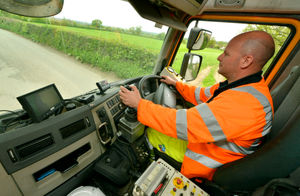
It is just as well that Gavin has such a clever piece of equipment at his disposal, as he and his colleagues have certainly got their work cut out.
In January alone, Shropshire Council received 1,200 reports of potholes. Last month, the council's cabinet member for highways, Councillor Steve Davenport, said he could never recall a time when the situation was so bad. "Many of our roads have been in a terrible state over the past few months following the severe winter weather," he said.
The Roadmaster is not the answer to all the problems with the county's roads, but it is a big help, says Mark Busby, of Shropshire's highway maintenance contractor Kier.
"It's not so good for the urban roads, because it tends to hold the traffic up, and people in the towns tend to demand a slightly higher standard of road surface," he says. "But it's ideal for the lanes, and a repair should last for up to five years."
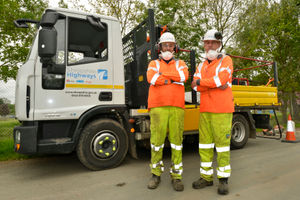
In urban areas, it falls to the traditional two-man crew to carry out the work, who like the Roadmaster operatros are given their programmes of work to carry out each day via a hand-held computer.
"If somebody reports a pothole, it will be inspected by the council, who will take a photograph and usually paint a circle around it," says Mr Busby.
They will then prioritise it according to its size and depth, the amount of traffic and its effect on road safety, and details of the job will then be passed on to the crews at Kier.

Emergency repairs, such as when there is an immediate threat to road safety, are carried out straight away, while others are prioritised as needing to be done in five days, 20 days, or as part of a future planned maintenance programme.
"If we are programmed to do it within five days, and we are a day over, the council will hit us with a financial penalty, so it is obviously important that we carry it out at the required time," says Mr Busby, who is now responsible for training the road crews.
Schemes manager John Flower says one of the biggest obstacles is getting the required permission to close the road while the work is carried out.
"If it is an emergency, we can do it straight away, but if it is part of a planned programme we have to give three months' notice."
Damage caused to cars hits £1m per month causing ‘epidemic’ problems
Potholes are costing drivers and insurers at least £1 million a month due to massive car repair bills, according to estimates released today from the AA.
The motoring organisation said the number of pothole-related claims it had seen during the first four months of 2018 alone was more than for the whole of 2017.
Based on its share of Britain’s car insurance market, the broker estimated that nationally there will have been more than 4,200 claims for pothole damage so far this year compared with just over 3,500 estimated claims across last year.
It described the number as an “epidemic” and a “national embarrassment”. With an estimated average repair bill of around £1,000, the total this year so far comes to “an eye-watering” £4.2m, or more than £1m per month, where drivers consider they have no option but to make an insurance claim.
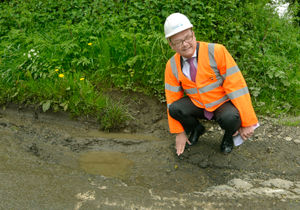
Janet Connor, the AA’s director of insurance, said: “In most cases the damage caused by a pothole – a ruined tyre or even two tyres and perhaps a wheel rim – doesn’t justify making an insurance claim given that it is likely to lead to the loss of your excess and no-claim bonus. So the claims we are seeing are clearly much worse than that.
“Drivers are hitting potholes and ruining their suspension, steering, the underbody of the car, breaking axles and occasionally being knocked off course and hitting other vehicles, kerbs or a lamppost. This year, we are seeing a growing number of pothole claims described as ‘car severely damaged and undriveable’ which didn’t happen at all last year. “The pothole epidemic has become nothing short of a national disgrace.”
The AA said a survey of more than 17,000 had found 88 per cent of drivers thought roads were in a worse state now than 10 years ago. Ms Connor said: “Local council budgets have been squeezed to the extent they don’t have the resources to keep roads up to scratch.”
The AA has launched a campaign under the hashtag FlagitFunditFillit to highlight what it says is a need “to invest in reversing the shocking deterioration of Britain’s roads”.
Drivers’ pothole woes have included a crater so deep it grounded a car leaving it stuck and a pothole lurking under a puddle which broke another car’s steering, the AA said.
It says potholes should be flagged up to the highway authority responsible so they are aware it exists.
Ms Connor said: “I would call on drivers to safely photograph the potholes they encounter and send them to the responsible highway authority and the Department for Transport by social media, to show them the extent of the pothole problem.
“We are also calling on the Government to ‘fund it’ by ring-fencing 2p per litre of current fuel duty to create a £1 billion pothole fund specifically to be channelled to local councils so they can get on top of their pothole problem.
“With that funding, councils can then ‘fill it’ and make their local roads safe for all road users whether on four wheels, two, or on foot.
“That way, compensation payments that could otherwise be used to keep roads in good repair, should dramatically fall.”


